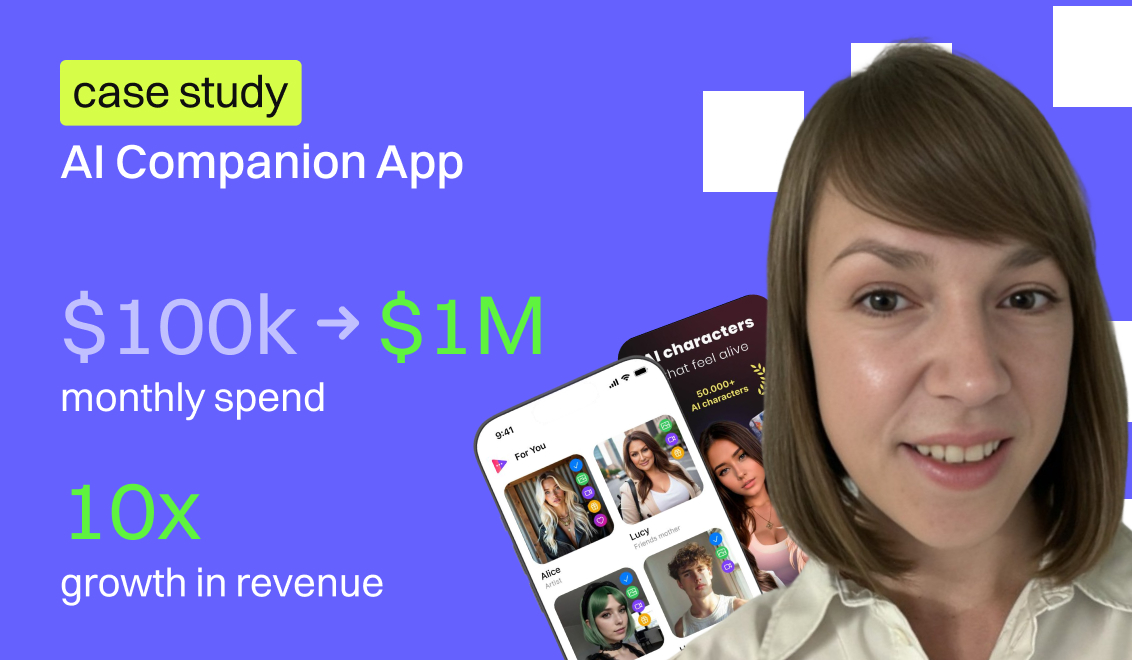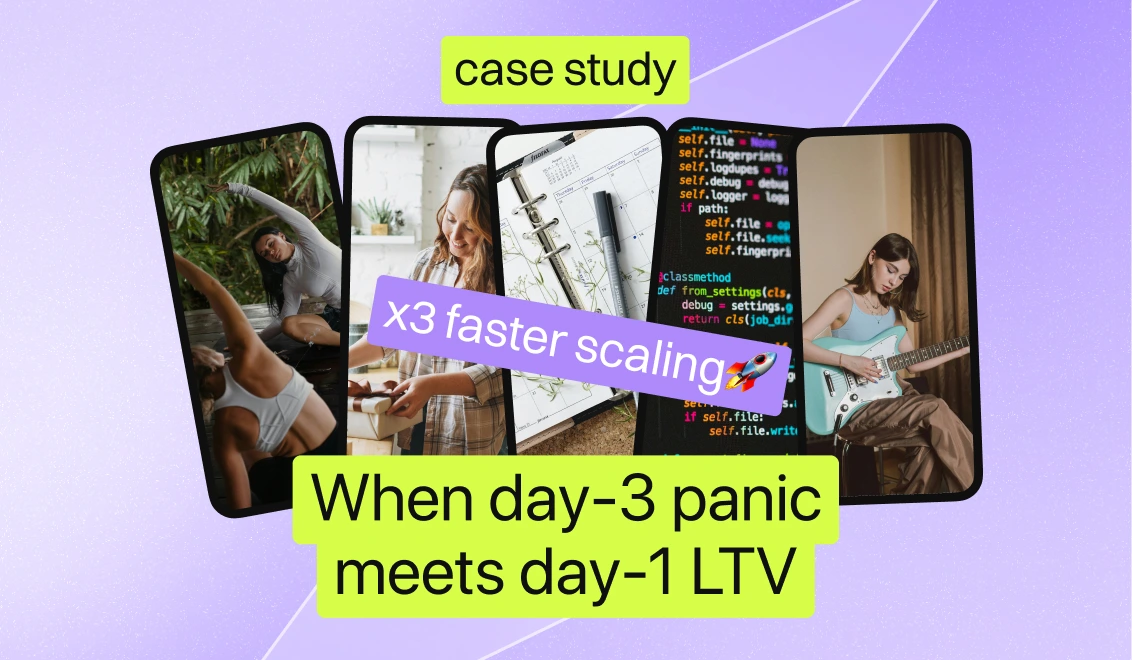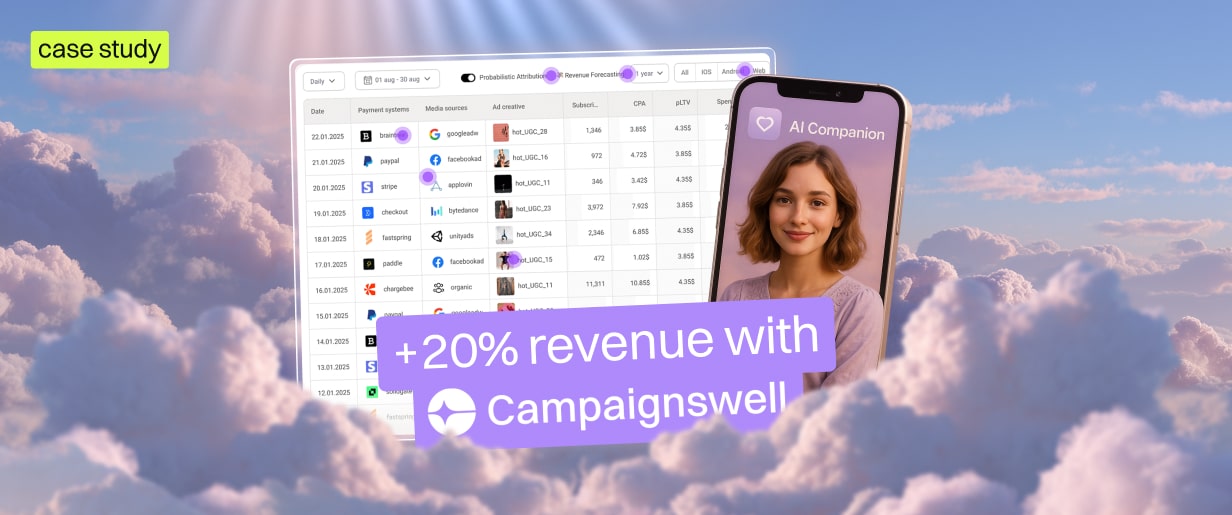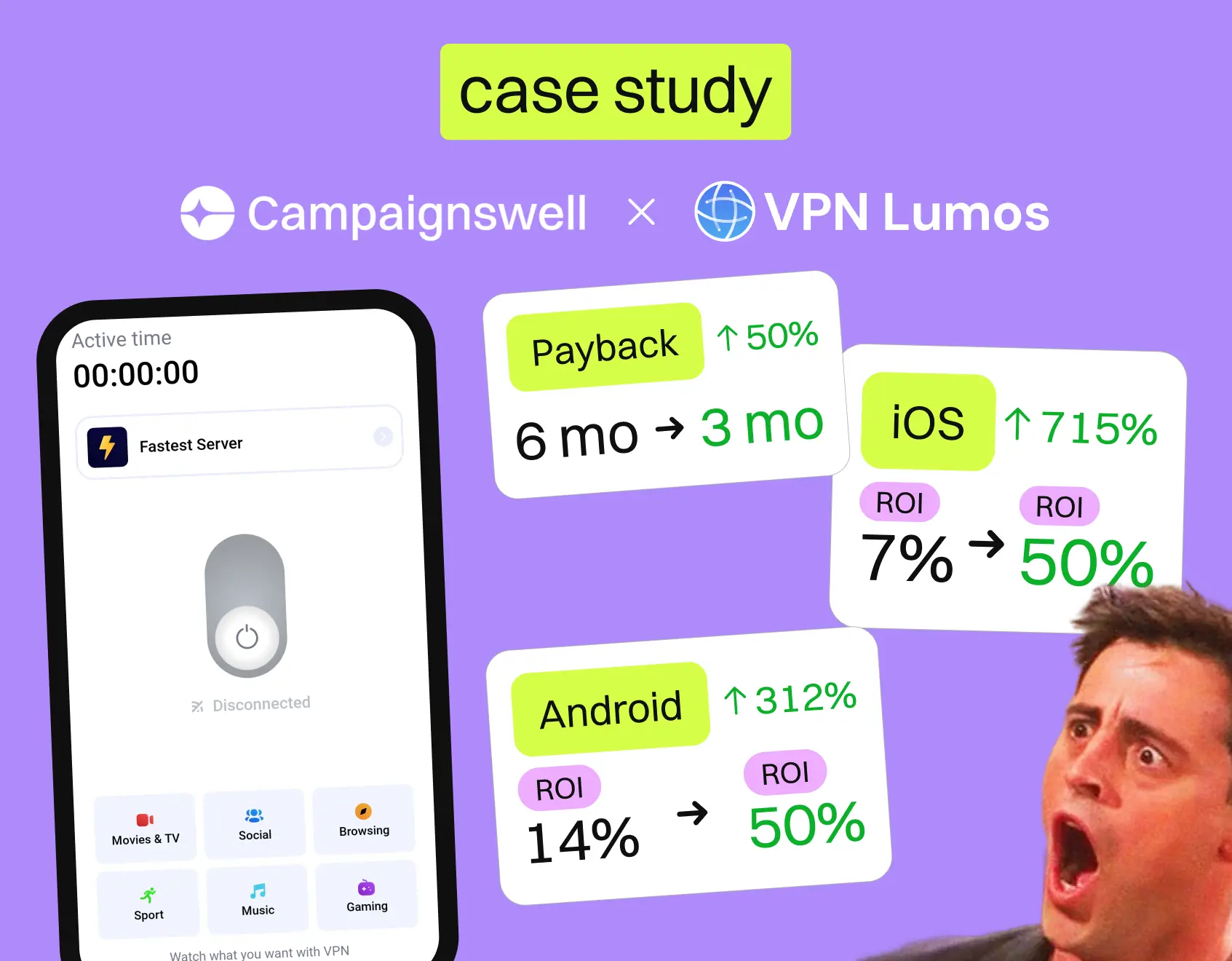How this mobile analytics startup scaled MRR 30x without a BI Team
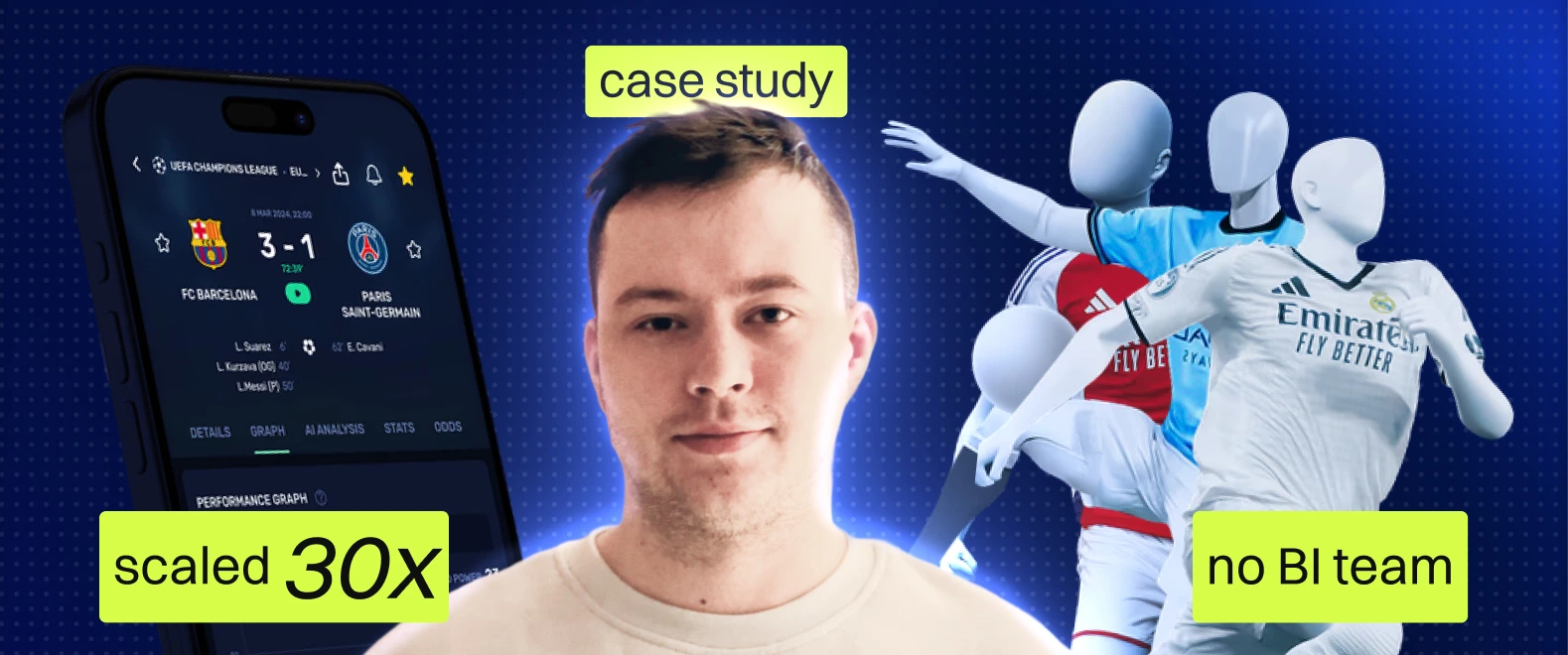
The year they launched paid UA, AIstats had no BI system, no attribution stack, and no way to see if campaigns were actually working but they were ready to go all in.
AIstats builds mobile analytics products, so they know better than most how much reliable data infrastructure matters. But when it came time to scale their own growth efforts, they were facing the same tangle of early-stage challenges as any startup. No BI system. No forecasts. No confidence in what their campaigns would earn.
With a $5K monthly budget and no visibility into outcomes, their only real guide was an internal CPA ceiling. If a campaign stayed under it, it lived. If not, it got cut. That was the whole strategy, no cohorts, no forecasts, just a single number holding it all together. And while the tactics were basic, the intention wasn’t. Their plans were already pointed well beyond test-budget territory. The scoreboard said mid-table spend, but behind the scenes they were drafting Champions League playbooks, serious about setup, knowing they’d need it when the game got real. So, at that stage, the team was still relying on a handful of key metrics like CPA thresholds, without deeper forecasting or cohort analysis.
The goal was to lay the groundwork for real, repeatable, data-driven acquisition. They needed to move from manual guesswork to systematic traffic buying. And to do that, they had to solve the foundational question: how do you build the kind of marketing intelligence stack that usually takes quarters to ship and a data team to run without any of those things?
That question led them straight to Campaignswell. What followed was a 12-month run that took them from $5K to $150K in MRR without ever hiring a BI analyst. Here's how they did it.
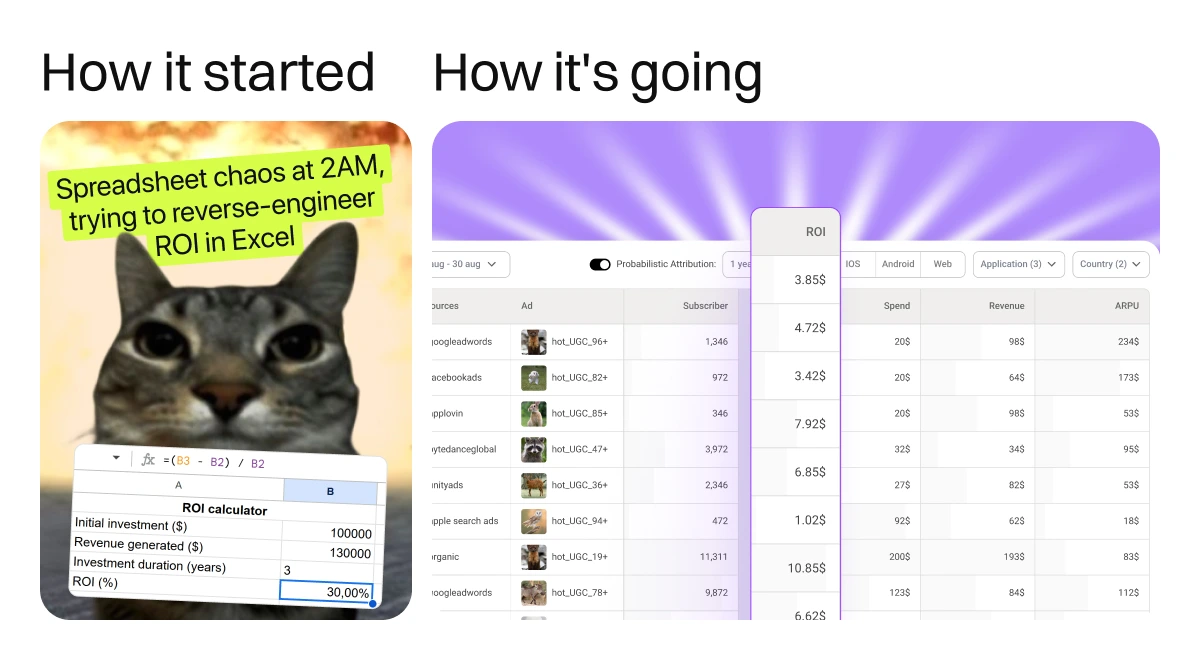
Building a UA engine before hitting the gas
There’s a moment in every early-stage product when campaigns stop being experiments and start becoming a channel. For AIstats, that moment came fast. The numbers were still small, but the mindset had already shifted: they were ready to build acquisition into a repeatable, scalable engine. And that meant stepping into a new game entirely.
Scaling paid traffic is a team sport, and teams need a playbook. Clear goals, reliable data, fast feedback — without that, there’s no process, just guesswork. Building a UA team means giving them tools to act on signals, not hunches. No one wins matches watching replays a month later.
That’s the point they hit. The question wasn’t whether to invest in growth, it was how to do it without burning six months or half their budget on BI tooling they couldn’t maintain. The only version of growth that made sense was one that came with real analytics from day one. A system that could show ROI fast, and predict it faster.
As CEO Yevgeny put it: "We didn’t even consider other options. Hiring analysts was out of scope, and we weren’t going to lose time or budget trying to build BI ourselves. The choice wasn’t between tools. It was between getting visibility or continuing in the dark."
So they made the call early: if they were going to build a UA engine, it needed a core. Campaignswell became that core before the engine ever started running.

How the decision got made
They were basically looking at three paths. Keep going as-is and hope instinct keeps holding up. Build a full BI stack the old-school way: months of setup, then hire a team to run it. Or plug into something ready-made that gives answers fast.
Staying in the dark wasn’t really on the table. Classic BI meant months of setup, a heavy lift on the tech side, and a full team just to keep it running. That kind of overhead made no sense for a team that needed answers now (and wanted to save some money, obviously). SaaS BI made far more sense: quick to start, easy to trust, and ready to scale with them, not ahead of them.
Yevgeny didn’t waste time making a list of options. He asked the people who’d already figured it out.
"I talked to a few people I trust in the space. Some had worked with Campaignswell already. Others knew the founders. Across the board, it was the same feedback: it works, it’s fast, it doesn’t require setup headaches. And when you’re small and moving fast, that kind of trust matters more than a checklist."
He was looking for a tool that could cut through the noise and give clear, actionable answers, something that made uncertainty irrelevant. And Campaignswell came with real-world proof from people in the same trenches.
Quick intro, while we’re at it
So, what is Campaignswell anyway?
It’s a SaaS BI layer built for growth teams who actually run campaigns. Think of it as your predictive control center: live dashboards, reliable forecasts, cohort health tracking — all in one place, ready to go.
It connects your marketing stack — Meta, TikTok, Apple, Google, Stripe, SKAN, and the rest — and gives you one clean view. Under the hood — a mathematical model trained to read user behavior and build revenue forecasts in real time.
Campaignswell doesn’t need a team of analysts to maintain. Everything updates at least once a day, so decisions stay current. You get predictive LTV and ROI, cohort profitability, creative performance, CAC, funnel retention, and day-zero-to-payback — all instantly available, no custom builds or SQL queries required.
It’s faster to set up, easier to use, and dramatically more cost-effective than a traditional BI stack. And because it’s purpose-built for UA, it speaks the same language your team does — with insights that actually move budgets.
That’s why you’ll hear about it from teams already scaling. Once traffic starts flowing and budgets grow, you need more than just reports — you need signal. Campaignswell helps you see what’s working, why it’s working, and what to do next.

From first forecasts to real revenue
The numbers tell part of the story. Two months after integrating Campaignswell, AIstats had already tripled their MRR up to $15K. Today, it’s hovering around $150K. What changed most was how confidently they could steer growth.
Where they once made decisions based on ballpark guesses and late-night Excel sessions, now there’s structure. Every morning, Yevgeny logs in and checks the same key metrics: what was yesterday’s spend, and what does the pLTV model say? From there, the UA team digs deeper, segmenting performance by cohort, platform, or funnel type. This routine helped them focus on retaining paying customers, spotting early signs of customer churn, and steering budget toward the channels that mattered most.
"It’s not even analysis anymore. It’s just a quick pulse check. I know yesterday’s ROI. I know how it compares to the day before. And when something changes, we move."
Even more telling is what they didn’t have to build. There was no dashboard backlog, no internal tools project, no fire-drills to reverse-engineer campaign performance. The predictions from Campaignswell became the team’s base layer, with deeper insights built around them.
Results: MRR growth and smarter financial forecasting
Once Campaignswell became part of the workflow, the tempo of growth shifted noticeably. Spend rose from $5K to $15K within just a few months and reached close to $150K per month over the following year. What could have felt hectic turned into a smooth and steady progression, thanks to identifying the key factors behind profitable campaigns, applying better financial forecasting, and consistently finding new ways to improve MRR.
The team moved forward with a sense of structure, supported not by hunches or guesswork, but by clear forecasts and actionable insights.
Their entire approach began to orbit around one core metric — a 30% ROI benchmark. That single number set the tone for decision-making, replacing the old model of reacting to CPA thresholds with something far more strategic. Every morning started the same way: a quick look at yesterday’s spend, a check on today’s predicted return, and from there, the day took shape with purpose and clarity.
With that foundation in place, the team was ready to explore new acquisition channels. The launch of their Web2Web funnel, running alongside the original Web2App flow, gave them the flexibility to expand while maintaining control. Performance didn’t take long to show up — LTV in the new funnel outpaced previous cohorts by 20 to 25 percent, and the data confirmed it almost instantly.
"Before, everything was Web2App. When we launched Web2Web, we needed full analytics support from day one. Attribution, LTV modeling, all of it. Campaignswell gave us that."
If you’ve ever led a team through rapid growth, you probably know the tug-of-war between bold moves and the fear of burning through cash. AIstats reached a point where that tension eased. They could see results as they happened, track patterns as they emerged, and move forward without second-guessing every step. Growth started to feel less like a gamble and more like the natural result of a system that finally made sense.
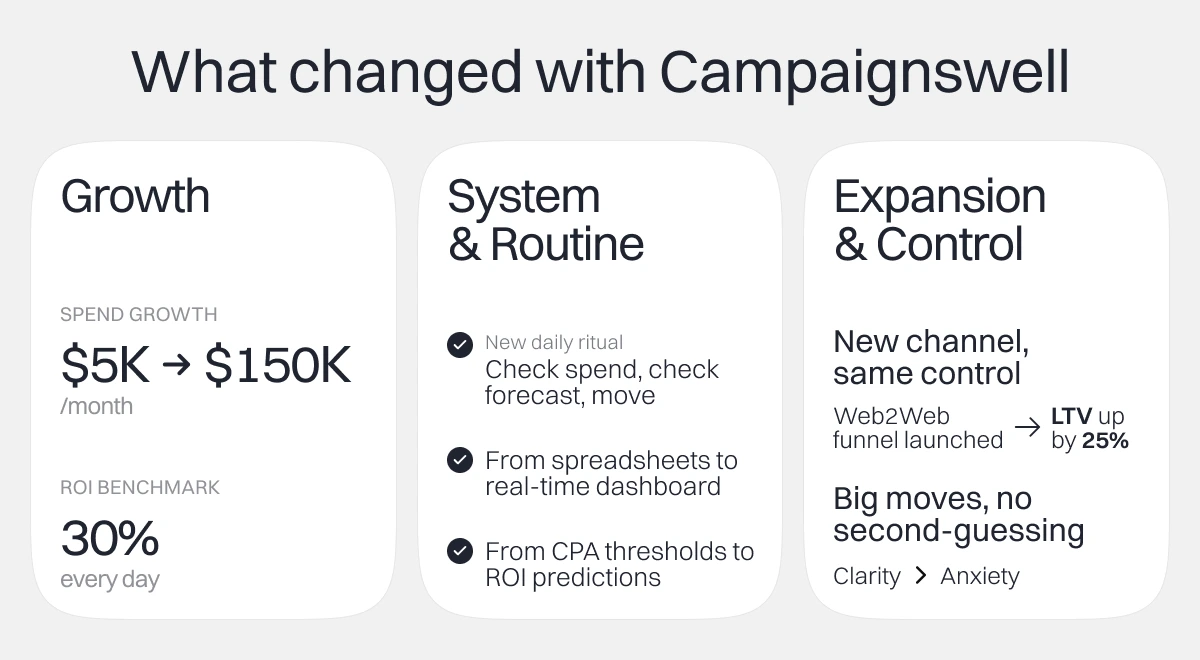
What they'd change (and what paid off anyway)
Looking back, Yevgeny does see one thing he might do differently. He admits that plugging in Campaignswell at the $5K/month stage may have been premature.
"Realistically, $15K/month in spend is probably the right point to add a BI layer like this. But we knew where we were going, and we needed the infrastructure to support that."
But that choice brought real benefits. While the team was still ramping spend, Campaignswell’s model was already learning from user behavior inside their product. So when growth picked up, the predictions were sharper, based on patterns that reflected their actual audience. That level of accuracy gave them an edge right when they needed it most.
"Without predictive LTV, you're basically gambling. At our scale now, it would be insane not to have it. I’ve heard too many stories about startups burning millions because they didn’t understand their own numbers. We weren’t going to be one of them."
Getting in early gave them more than a working setup. It gave them a model that understood their business, and a rhythm that made scale feel like the natural next step.
The foundation behind 30x MRR growth
In a market where tools often promise the moon, what makes Campaignswell stand out is how unassuming it is. It just works. The biggest win for AIstats was getting clear, reliable signal that kept the team in sync and the growth on track. The platform replaced hours of manual checking with fast, automated insight, and it gave a lean team the kind of firepower usually reserved for scaled orgs with full-blown BI departments.
"I never even got around to looking at competitors. I’m sure there are other tools. But nothing else came recommended the way Campaignswell did. And once we were in, we didn’t look back."
The BI stack at AIstats is now a single tab. Their UA team has the visibility they need, finance trusts the numbers, the company can clearly see how growth impacts both new and existing customers. And CEO gets to spend more time steering growth, and less time wondering if their forecasts will hold up.
Planning to boost your growth and looking for the right tools to back it up?
We’re here for it and ready to show exactly how it can work for your team.
Book a demo.

Co-founder & CEO at Campaignswell


